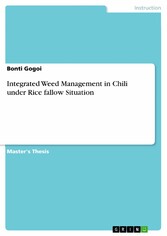Search and Find
Service
Integrated Weed Management in Chili under Rice fallow Situation
Master's Thesis from the year 2013 in the subject Instructor Plans: Agriculture / Forestry / Gardening, Assam University (COLLEGE OF AGRICULTURE), course: AGRONOMY, language: English, abstract: A field experiment was conducted at the Instructional-cum-Research (ICR) farm of Assam Agricultural University in 2012 to study the effect of weed management practices on growth and yield of chili after winter rice. The treatments comprised of ten different weed management practices including control. The experiment was laid out in Randomized Block Design (RBD) with three replications. The study revealed that the weed density as well as dry weight were lowest in the treatments with metribuzin @ 500 g/ha combined with garden hoeing at 30, 60 or 30, 50, 60 or 30, 60, 80 days after planting over the rest of the treatments. Among the weed management treatments, a higher weed density was observed in the three treatments of quizalofop-p-ethyl @ 50 g/ha followed by garden hoeing at 45, 75 or 60, 80 or 50, 80 days after planting. Plant height, days to 50 per cent flowering, numbers of primary and secondary branches were highest in metribuzin treated plots. Length of fruit and stalk, fruit girth, number of seeds per fruit, number of fruits per plant and yield per plant were relatively higher with treatments involving metribuzin. The fruit yield (fresh and dry) was also found to be higher in the metribuzin treated plots. Mechanical weeding with garden hoe alone closely followed metribuzin treatments in respect of fruit yield. The available nutrient was found to be lower in the plots with metribuzin treatment or mechanically weeded with only garden hoeing at different intervals. The yield loss due to uncontrolled weeds in weedy check (287 kg/ha) as compared to the highest yield (3417 kg/ha fresh chili) obtained from metribuzin 500 g/ha + garden hoeing at 30, 50 and 80 DAP was 91 per cent. The benefit-cost ratio was found to be highest ( 2.60) in metribuzin @ 500 g/ha along with garden hoeing 30, 50, 80 days after planting. The biochemical attributes like ascorbic acid (62.1 mg/100g) and capsaicin content ( - 60.6 mg/100g) were found to be significantly higher in metribuzin @ 500 g/ha with garden hoeing at 30 and 60 or 30, 50 and 80 days after planting over the above treatments. From this study, it could be inferred that application of metribuzin @ 500 g/ha with garden hoeing at 30, 50, 60 days after planting controlled the weeds in chili effectively and resulted higher fruit yield, quality of chili and economic return.
All prices incl. VAT












